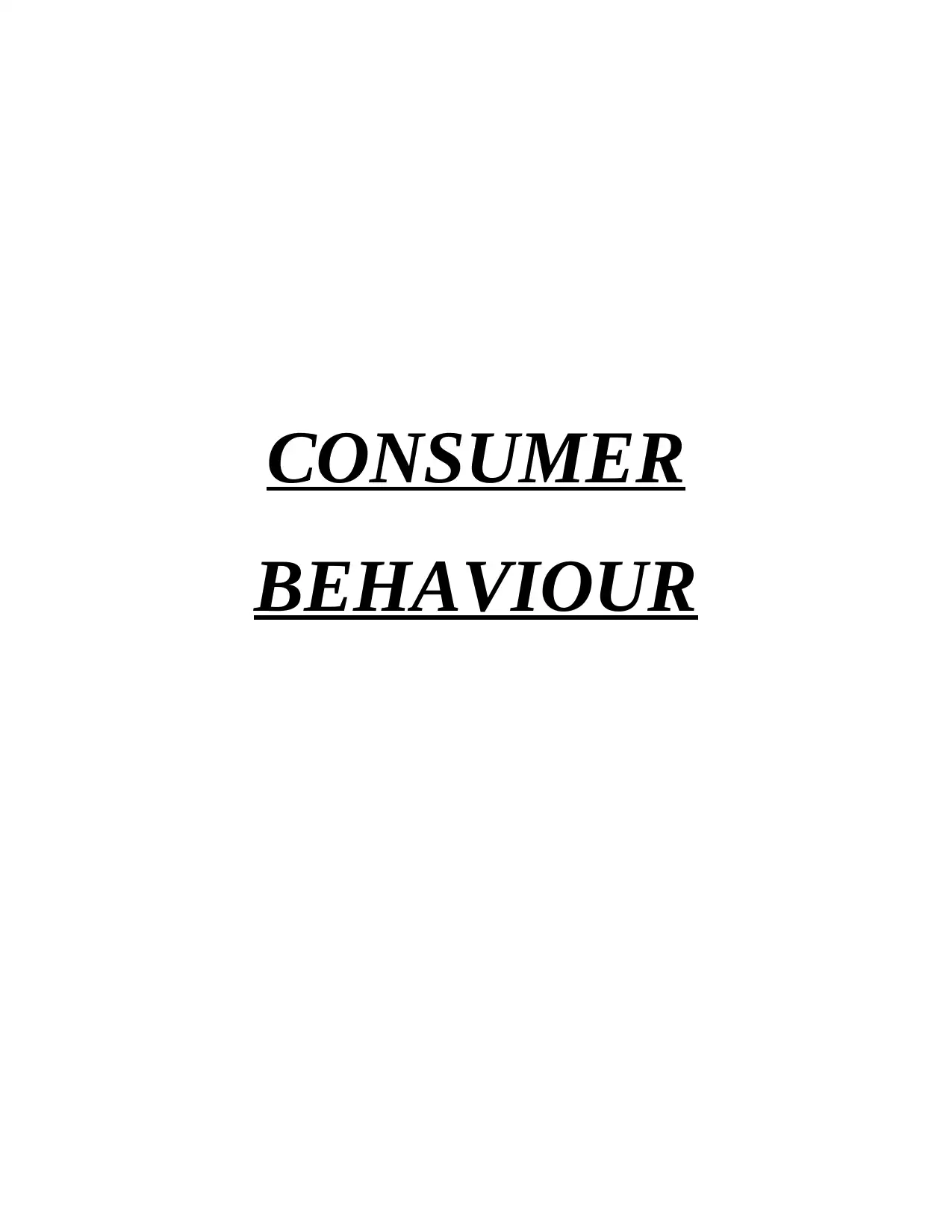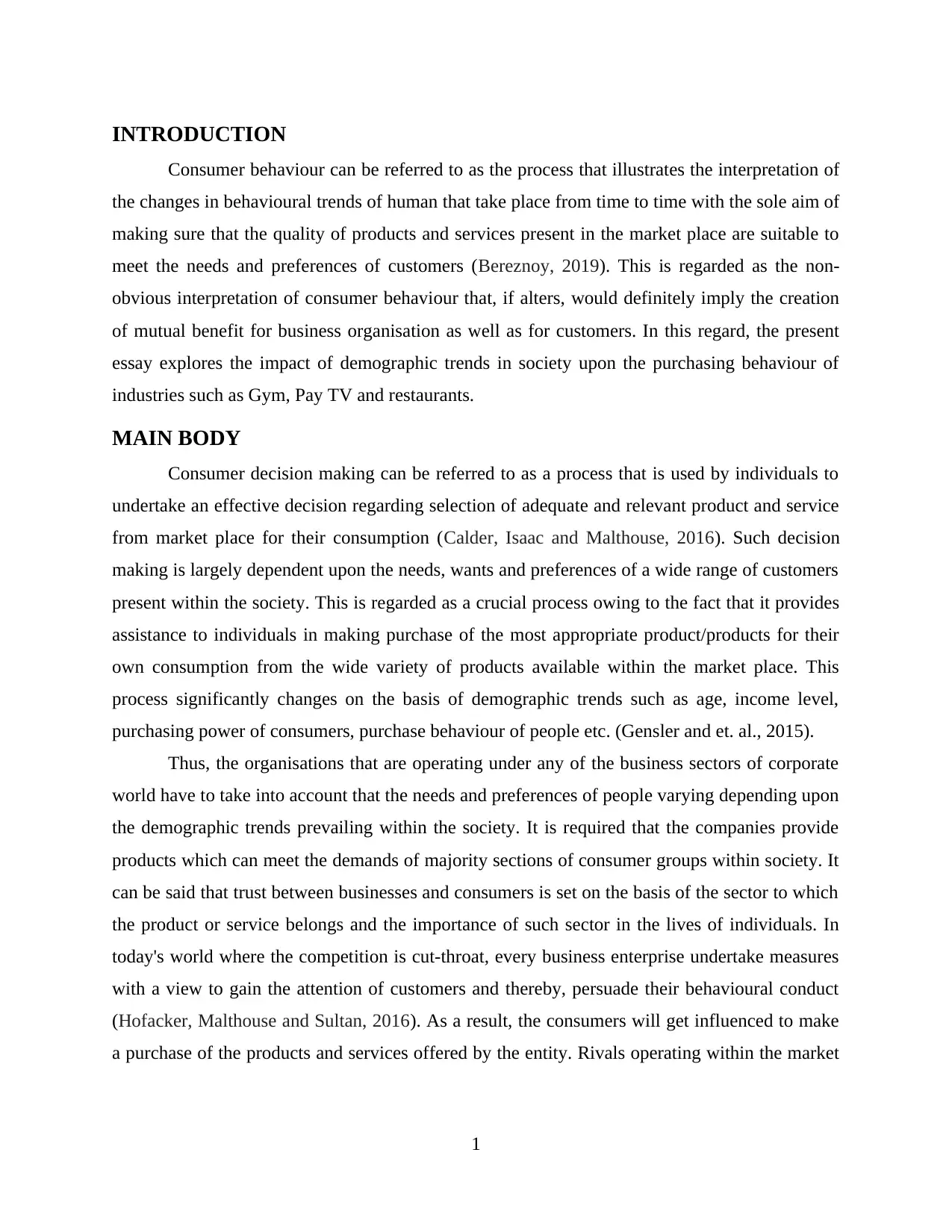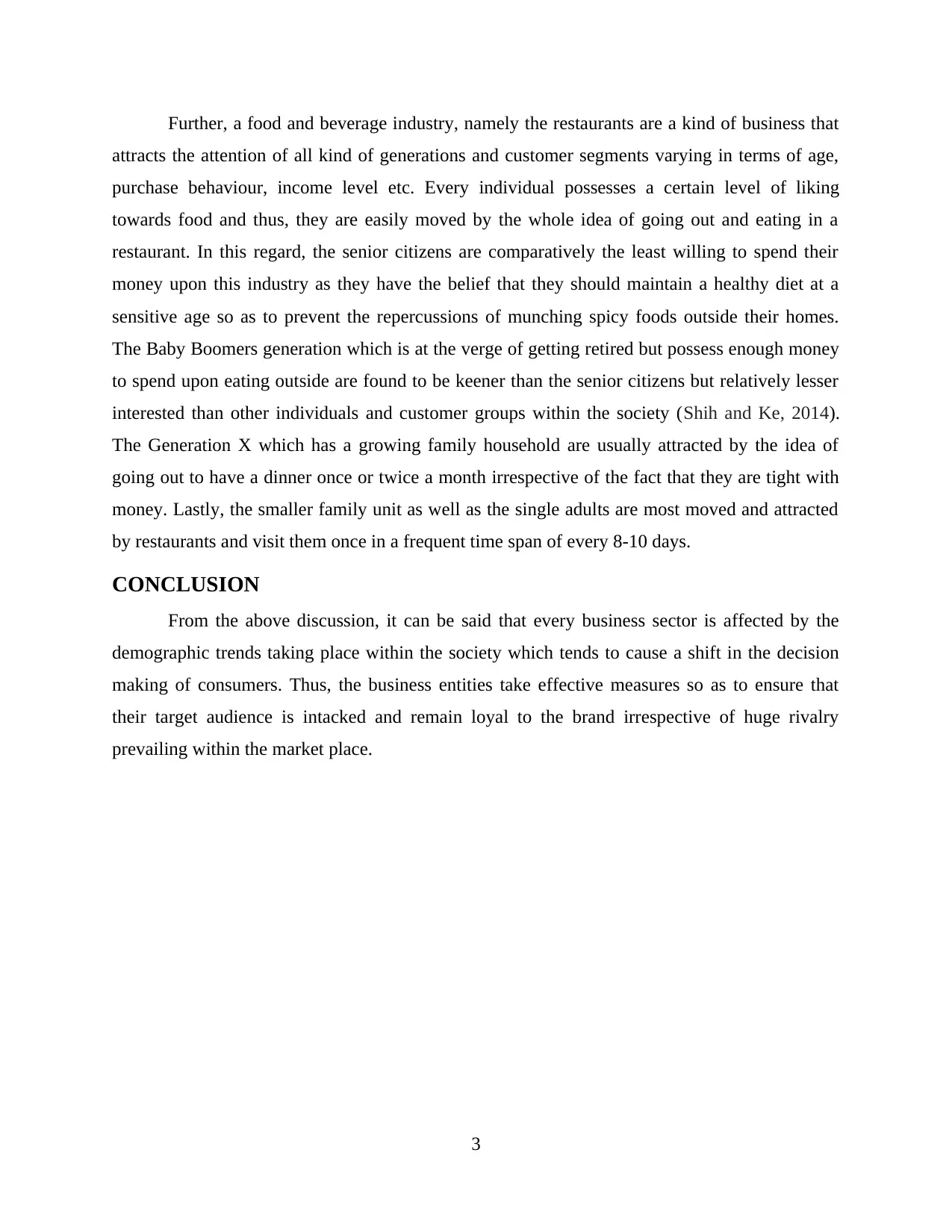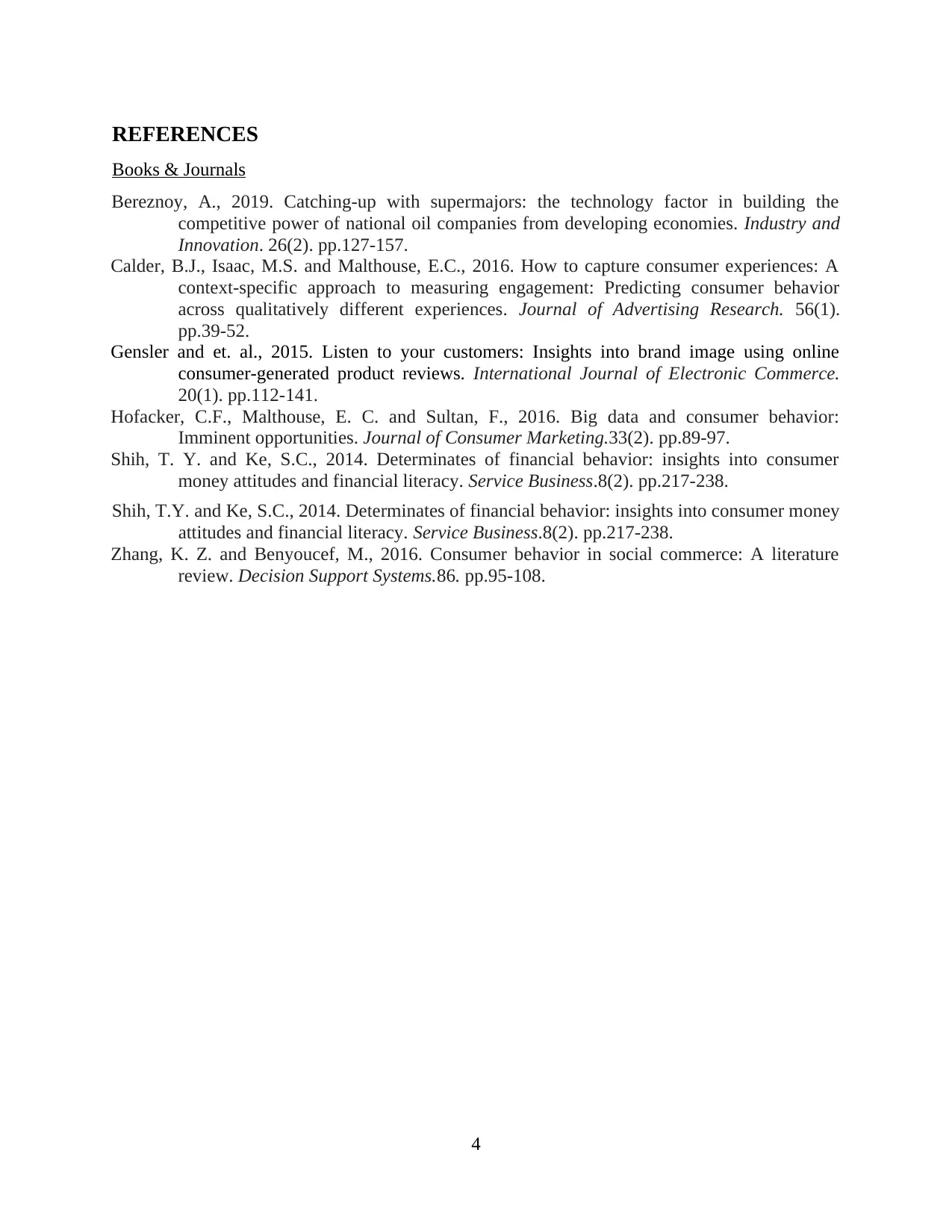Consumer Behaviour: Demographic Trends in Business Sectors
VerifiedAdded on 2020/10/22
|7
|1493
|122
Essay
AI Summary
This essay delves into the realm of consumer behavior, elucidating how demographic trends significantly influence purchasing decisions across various industries. It begins by defining consumer behavior as the interpretation of changing human behavioral patterns to align product and service quality with customer needs and preferences. The essay then explores the impact of demographic factors such as age, income, and purchasing power on consumer choices within the gym, pay TV, and restaurant sectors. It highlights how businesses must adapt to these trends to meet the demands of diverse consumer groups. The analysis reveals that the fitness industry is heavily influenced by age and purchasing behavior, with senior citizens and the Baby Boomer generation being more or less inclined to utilize fitness services. Pay TV subscriptions are favored by younger generations, while older demographics show less interest. Restaurants, on the other hand, attract a broad range of demographics, with varying levels of spending based on age, family size, and income. The essay concludes by emphasizing the importance of businesses understanding and responding to these demographic shifts to maintain customer loyalty and competitiveness in the market.

CONSUMER
BEHAVIOUR
BEHAVIOUR
Paraphrase This Document
Need a fresh take? Get an instant paraphrase of this document with our AI Paraphraser

Table of Contents
INTRODUCTION...........................................................................................................................1
MAIN BODY...................................................................................................................................1
CONCLUSION................................................................................................................................3
REFERENCES................................................................................................................................4
INTRODUCTION...........................................................................................................................1
MAIN BODY...................................................................................................................................1
CONCLUSION................................................................................................................................3
REFERENCES................................................................................................................................4

⊘ This is a preview!⊘
Do you want full access?
Subscribe today to unlock all pages.

Trusted by 1+ million students worldwide

INTRODUCTION
Consumer behaviour can be referred to as the process that illustrates the interpretation of
the changes in behavioural trends of human that take place from time to time with the sole aim of
making sure that the quality of products and services present in the market place are suitable to
meet the needs and preferences of customers (Bereznoy, 2019). This is regarded as the non-
obvious interpretation of consumer behaviour that, if alters, would definitely imply the creation
of mutual benefit for business organisation as well as for customers. In this regard, the present
essay explores the impact of demographic trends in society upon the purchasing behaviour of
industries such as Gym, Pay TV and restaurants.
MAIN BODY
Consumer decision making can be referred to as a process that is used by individuals to
undertake an effective decision regarding selection of adequate and relevant product and service
from market place for their consumption (Calder, Isaac and Malthouse, 2016). Such decision
making is largely dependent upon the needs, wants and preferences of a wide range of customers
present within the society. This is regarded as a crucial process owing to the fact that it provides
assistance to individuals in making purchase of the most appropriate product/products for their
own consumption from the wide variety of products available within the market place. This
process significantly changes on the basis of demographic trends such as age, income level,
purchasing power of consumers, purchase behaviour of people etc. (Gensler and et. al., 2015).
Thus, the organisations that are operating under any of the business sectors of corporate
world have to take into account that the needs and preferences of people varying depending upon
the demographic trends prevailing within the society. It is required that the companies provide
products which can meet the demands of majority sections of consumer groups within society. It
can be said that trust between businesses and consumers is set on the basis of the sector to which
the product or service belongs and the importance of such sector in the lives of individuals. In
today's world where the competition is cut-throat, every business enterprise undertake measures
with a view to gain the attention of customers and thereby, persuade their behavioural conduct
(Hofacker, Malthouse and Sultan, 2016). As a result, the consumers will get influenced to make
a purchase of the products and services offered by the entity. Rivals operating within the market
1
Consumer behaviour can be referred to as the process that illustrates the interpretation of
the changes in behavioural trends of human that take place from time to time with the sole aim of
making sure that the quality of products and services present in the market place are suitable to
meet the needs and preferences of customers (Bereznoy, 2019). This is regarded as the non-
obvious interpretation of consumer behaviour that, if alters, would definitely imply the creation
of mutual benefit for business organisation as well as for customers. In this regard, the present
essay explores the impact of demographic trends in society upon the purchasing behaviour of
industries such as Gym, Pay TV and restaurants.
MAIN BODY
Consumer decision making can be referred to as a process that is used by individuals to
undertake an effective decision regarding selection of adequate and relevant product and service
from market place for their consumption (Calder, Isaac and Malthouse, 2016). Such decision
making is largely dependent upon the needs, wants and preferences of a wide range of customers
present within the society. This is regarded as a crucial process owing to the fact that it provides
assistance to individuals in making purchase of the most appropriate product/products for their
own consumption from the wide variety of products available within the market place. This
process significantly changes on the basis of demographic trends such as age, income level,
purchasing power of consumers, purchase behaviour of people etc. (Gensler and et. al., 2015).
Thus, the organisations that are operating under any of the business sectors of corporate
world have to take into account that the needs and preferences of people varying depending upon
the demographic trends prevailing within the society. It is required that the companies provide
products which can meet the demands of majority sections of consumer groups within society. It
can be said that trust between businesses and consumers is set on the basis of the sector to which
the product or service belongs and the importance of such sector in the lives of individuals. In
today's world where the competition is cut-throat, every business enterprise undertake measures
with a view to gain the attention of customers and thereby, persuade their behavioural conduct
(Hofacker, Malthouse and Sultan, 2016). As a result, the consumers will get influenced to make
a purchase of the products and services offered by the entity. Rivals operating within the market
1
Paraphrase This Document
Need a fresh take? Get an instant paraphrase of this document with our AI Paraphraser

sector take every possible step and formulate every strategy to solicit the customers of a
company to increase their customer base and consequently, their sales as well as profits.
The decision making of consumers largely upon the industry regarding which they have
to make judgements in relation to purchase. In this concern, fitness industry is a sector which is
largely effected by demographic trends such as age and purchase behaviour. The senior citizens
generally are not willing to make a purchase of fitness services, however a health conscious
segment of these is influenced to make use of gyms in order to enhance their life span and carry
out their living in a healthy manner (Zhang and Benyoucef, 2016). Further, the baby boomers
generation which is leaning forward towards retirement have enough money to incur upon taking
fitness services and thus they can be easily persuaded by businesses operating within this sector.
Further, it is generally seen that the Generation X which has a huge mortgage and ever
increasing family household are tight with money and are not easily persuaded by gyms or
fitness centres. Besides this, the single adult households whose money expenditure is incurred on
things of every day use are least interested in making use of fitness services. This demonstrates
that the gym or the fitness industry is largely affected by the age and purchasing behaviour of
individuals prevailing within a society.
Pay television refers to subscription based television services that are generally rendered
by analog as well as digital cable and satellite television but have also now started being
provided by digital terrestrial and internet television. Pay TV or subscription based television
started in multi channel transition. Some countries across the globe such as Latin America,
United States and France have even provided encrypted analog terrestrial signals accessible for
subscription. The most famous Pay TV medium includes Netflix, Stan, Presto and Foxtel which
are widely used by people across the globe (Shih and Ke, 2014). Such subscription based
television is usually preferred by the young generation which is always keen to watch new shows
and series on the basis of a paid subscription. The senior citizens as well as the Baby Boomers
Generation are both unwilling to make use of Pay TV services as they are relatively lesser moved
by the idea of a subscription based TV and rather like to spend an hour watching TV on the
electronic equipment present in their dining rooms. Further, their spending behaviour is also not
flexible towards this industry owing to the fact that they are not so tech savy to have knowledge
of getting subscription and then watching shows.
2
company to increase their customer base and consequently, their sales as well as profits.
The decision making of consumers largely upon the industry regarding which they have
to make judgements in relation to purchase. In this concern, fitness industry is a sector which is
largely effected by demographic trends such as age and purchase behaviour. The senior citizens
generally are not willing to make a purchase of fitness services, however a health conscious
segment of these is influenced to make use of gyms in order to enhance their life span and carry
out their living in a healthy manner (Zhang and Benyoucef, 2016). Further, the baby boomers
generation which is leaning forward towards retirement have enough money to incur upon taking
fitness services and thus they can be easily persuaded by businesses operating within this sector.
Further, it is generally seen that the Generation X which has a huge mortgage and ever
increasing family household are tight with money and are not easily persuaded by gyms or
fitness centres. Besides this, the single adult households whose money expenditure is incurred on
things of every day use are least interested in making use of fitness services. This demonstrates
that the gym or the fitness industry is largely affected by the age and purchasing behaviour of
individuals prevailing within a society.
Pay television refers to subscription based television services that are generally rendered
by analog as well as digital cable and satellite television but have also now started being
provided by digital terrestrial and internet television. Pay TV or subscription based television
started in multi channel transition. Some countries across the globe such as Latin America,
United States and France have even provided encrypted analog terrestrial signals accessible for
subscription. The most famous Pay TV medium includes Netflix, Stan, Presto and Foxtel which
are widely used by people across the globe (Shih and Ke, 2014). Such subscription based
television is usually preferred by the young generation which is always keen to watch new shows
and series on the basis of a paid subscription. The senior citizens as well as the Baby Boomers
Generation are both unwilling to make use of Pay TV services as they are relatively lesser moved
by the idea of a subscription based TV and rather like to spend an hour watching TV on the
electronic equipment present in their dining rooms. Further, their spending behaviour is also not
flexible towards this industry owing to the fact that they are not so tech savy to have knowledge
of getting subscription and then watching shows.
2

Further, a food and beverage industry, namely the restaurants are a kind of business that
attracts the attention of all kind of generations and customer segments varying in terms of age,
purchase behaviour, income level etc. Every individual possesses a certain level of liking
towards food and thus, they are easily moved by the whole idea of going out and eating in a
restaurant. In this regard, the senior citizens are comparatively the least willing to spend their
money upon this industry as they have the belief that they should maintain a healthy diet at a
sensitive age so as to prevent the repercussions of munching spicy foods outside their homes.
The Baby Boomers generation which is at the verge of getting retired but possess enough money
to spend upon eating outside are found to be keener than the senior citizens but relatively lesser
interested than other individuals and customer groups within the society (Shih and Ke, 2014).
The Generation X which has a growing family household are usually attracted by the idea of
going out to have a dinner once or twice a month irrespective of the fact that they are tight with
money. Lastly, the smaller family unit as well as the single adults are most moved and attracted
by restaurants and visit them once in a frequent time span of every 8-10 days.
CONCLUSION
From the above discussion, it can be said that every business sector is affected by the
demographic trends taking place within the society which tends to cause a shift in the decision
making of consumers. Thus, the business entities take effective measures so as to ensure that
their target audience is intacked and remain loyal to the brand irrespective of huge rivalry
prevailing within the market place.
3
attracts the attention of all kind of generations and customer segments varying in terms of age,
purchase behaviour, income level etc. Every individual possesses a certain level of liking
towards food and thus, they are easily moved by the whole idea of going out and eating in a
restaurant. In this regard, the senior citizens are comparatively the least willing to spend their
money upon this industry as they have the belief that they should maintain a healthy diet at a
sensitive age so as to prevent the repercussions of munching spicy foods outside their homes.
The Baby Boomers generation which is at the verge of getting retired but possess enough money
to spend upon eating outside are found to be keener than the senior citizens but relatively lesser
interested than other individuals and customer groups within the society (Shih and Ke, 2014).
The Generation X which has a growing family household are usually attracted by the idea of
going out to have a dinner once or twice a month irrespective of the fact that they are tight with
money. Lastly, the smaller family unit as well as the single adults are most moved and attracted
by restaurants and visit them once in a frequent time span of every 8-10 days.
CONCLUSION
From the above discussion, it can be said that every business sector is affected by the
demographic trends taking place within the society which tends to cause a shift in the decision
making of consumers. Thus, the business entities take effective measures so as to ensure that
their target audience is intacked and remain loyal to the brand irrespective of huge rivalry
prevailing within the market place.
3
⊘ This is a preview!⊘
Do you want full access?
Subscribe today to unlock all pages.

Trusted by 1+ million students worldwide

REFERENCES
Books & Journals
Bereznoy, A., 2019. Catching-up with supermajors: the technology factor in building the
competitive power of national oil companies from developing economies. Industry and
Innovation. 26(2). pp.127-157.
Calder, B.J., Isaac, M.S. and Malthouse, E.C., 2016. How to capture consumer experiences: A
context-specific approach to measuring engagement: Predicting consumer behavior
across qualitatively different experiences. Journal of Advertising Research. 56(1).
pp.39-52.
Gensler and et. al., 2015. Listen to your customers: Insights into brand image using online
consumer-generated product reviews. International Journal of Electronic Commerce.
20(1). pp.112-141.
Hofacker, C.F., Malthouse, E. C. and Sultan, F., 2016. Big data and consumer behavior:
Imminent opportunities. Journal of Consumer Marketing.33(2). pp.89-97.
Shih, T. Y. and Ke, S.C., 2014. Determinates of financial behavior: insights into consumer
money attitudes and financial literacy. Service Business.8(2). pp.217-238.
Shih, T.Y. and Ke, S.C., 2014. Determinates of financial behavior: insights into consumer money
attitudes and financial literacy. Service Business.8(2). pp.217-238.
Zhang, K. Z. and Benyoucef, M., 2016. Consumer behavior in social commerce: A literature
review. Decision Support Systems.86. pp.95-108.
4
Books & Journals
Bereznoy, A., 2019. Catching-up with supermajors: the technology factor in building the
competitive power of national oil companies from developing economies. Industry and
Innovation. 26(2). pp.127-157.
Calder, B.J., Isaac, M.S. and Malthouse, E.C., 2016. How to capture consumer experiences: A
context-specific approach to measuring engagement: Predicting consumer behavior
across qualitatively different experiences. Journal of Advertising Research. 56(1).
pp.39-52.
Gensler and et. al., 2015. Listen to your customers: Insights into brand image using online
consumer-generated product reviews. International Journal of Electronic Commerce.
20(1). pp.112-141.
Hofacker, C.F., Malthouse, E. C. and Sultan, F., 2016. Big data and consumer behavior:
Imminent opportunities. Journal of Consumer Marketing.33(2). pp.89-97.
Shih, T. Y. and Ke, S.C., 2014. Determinates of financial behavior: insights into consumer
money attitudes and financial literacy. Service Business.8(2). pp.217-238.
Shih, T.Y. and Ke, S.C., 2014. Determinates of financial behavior: insights into consumer money
attitudes and financial literacy. Service Business.8(2). pp.217-238.
Zhang, K. Z. and Benyoucef, M., 2016. Consumer behavior in social commerce: A literature
review. Decision Support Systems.86. pp.95-108.
4
1 out of 7
Related Documents
Your All-in-One AI-Powered Toolkit for Academic Success.
+13062052269
info@desklib.com
Available 24*7 on WhatsApp / Email
![[object Object]](/_next/static/media/star-bottom.7253800d.svg)
Unlock your academic potential
Copyright © 2020–2025 A2Z Services. All Rights Reserved. Developed and managed by ZUCOL.




